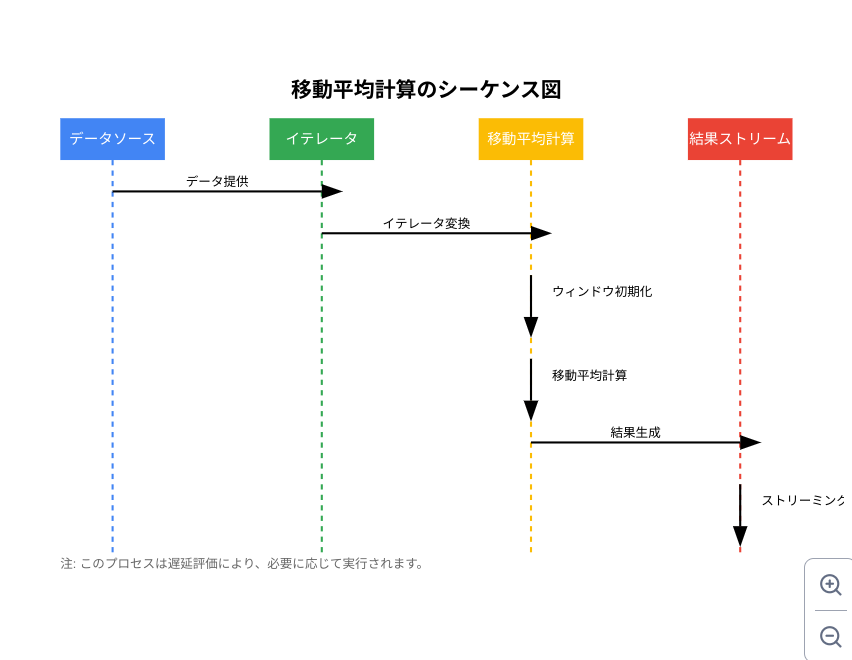はじめに
時系列データの分析において、移動平均は不可欠なツールです。この記事では、Pythonを使用して効率的に移動平均を計算する高度な方法を探ります。特に、itertoolsモジュールのイテレータチェーンを活用したストリーミング処理に焦点を当て、その内部動作と最適化について深く掘り下げていきます。
移動平均の基本と応用
移動平均は、時系列データの各点について、その点を中心とする一定期間のデータの平均を計算したものです。単純移動平均(SMA)以外にも、以下のような変種があります:
- 加重移動平均(WMA): 新しいデータにより大きな重みを付ける
- 指数移動平均(EMA): 過去のデータの影響が指数関数的に減衰する
- 中央移動平均: 中央値を使用してノイズに強い平滑化を行う
本記事では単純移動平均に焦点を当てますが、ここで紹介する技術は他の種類の移動平均にも応用可能です。
イテレータチェーンを使用した実装
以下に、Pythonのitertoolsモジュールを使用した効率的な移動平均の計算方法を示します。
from itertools import chain, islice
from collections import deque
from typing import Iterable, List, Union
def moving_average(iterable: Iterable[float], n: int) -> Iterable[float]:
it = iter(iterable)
d = deque(islice(it, n-1))
d.appendleft(0)
s = sum(d)
for elem in it:
s += elem - d.popleft()
d.append(elem)
yield s / n
def stream_moving_average(stream: Iterable[Union[int, float]], window_size: int) -> Iterable[float]:
return chain(
[float('nan')] * (window_size // 2),
moving_average(stream, window_size),
[float('nan')] * (window_size - 1 - window_size // 2)
)
# 使用例と出力
data = [1, 2, 3, 4, 5, 6, 7, 8, 9, 10]
window_size = 3
print("原データ:", data)
print(f"{window_size}点移動平均:")
result = list(stream_moving_average(data, window_size))
for i, value in enumerate(result):
print(f" 位置 {i}: {value:.2f}")
出力例
原データ: [1, 2, 3, 4, 5, 6, 7, 8, 9, 10]
3点移動平均:
位置 0: nan
位置 1: 2.00
位置 2: 3.00
位置 3: 4.00
位置 4: 5.00
位置 5: 6.00
位置 6: 7.00
位置 7: 8.00
位置 8: 9.00
位置 9: nan
この出力例から、以下のことが分かります:
- 移動平均の計算は、指定されたウィンドウサイズ(この場合は3点)で行われています。
- 出力の長さは入力データと同じです。
- 系列の始めと終わりには
nan(Not a Number) が挿入されており、これは十分なデータポイントがない位置を示しています。 - 中央の値は、その位置を中心とする3点の平均になっています。
実装の詳細解説
-
イテレータの使用:
iter(iterable)を使用して入力をイテレータに変換しています。これにより、入力がリストやジェネレータなど、どのような形式でも柔軟に対応できます。 -
dequeの活用:
collections.dequeは両端キューで、先頭と末尾の要素の追加・削除が O(1) の時間複雑度で行えます。これにより、ウィンドウのスライディングを効率的に実装できます。 -
islice の使用:
itertools.isliceを使用して、イテレータから最初のn-1個の要素を効率的に取得しています。これにより、最初のウィンドウを初期化する際のメモリ使用を最小限に抑えています。 -
ストリーミング処理:
yieldキーワードを使用してジェネレータを作成し、メモリ効率の良いストリーミング処理を実現しています。 -
NaNの追加:
stream_moving_average関数では、itertools.chainを使用して、ストリームの始めと終わりに NaN 値を追加しています。これにより、入力と同じ長さの出力を生成し、データの位置を保持しています。
パフォーマンスの最適化
-
累積和の更新: 各ステップで合計を再計算するのではなく、新しい要素を加え、古い要素を引くことで、計算量を O(n) から O(1) に削減しています。
-
メモリ使用の最適化:
dequeの使用により、固定サイズのウィンドウをメモリ効率良く管理しています。大規模なデータセットでも、使用メモリは一定に保たれます。 -
遅延評価: イテレータとジェネレータを使用することで、必要になるまで計算を遅延させています。これにより、大規模データセットや無限ストリームにも対応できます。
使用例と可視化
より複雑なシナリオとして、リアルタイムデータストリームのシミュレーションと、それに対する移動平均の計算を行ってみましょう。
import matplotlib.pyplot as plt
import numpy as np
from itertools import islice
def data_stream():
np.random.seed(42)
while True:
yield np.random.randn()
def visualize_real_time_ma(stream, window_size, num_points):
data = list(islice(stream, num_points))
ma = list(stream_moving_average(data, window_size))
plt.figure(figsize=(12, 6))
plt.plot(data, label='Raw Data', alpha=0.5)
plt.plot(ma, label=f'{window_size}-point Moving Average', linewidth=2)
plt.legend()
plt.title('Real-time Data Stream with Moving Average')
plt.xlabel('Time')
plt.ylabel('Value')
plt.show()
# シミュレーション実行
visualize_real_time_ma(data_stream(), window_size=21, num_points=1000)
# 最初の10ポイントの出力例
print("最初の10ポイント:")
stream = data_stream()
ma_stream = stream_moving_average(stream, 21)
for i, (data_point, ma_point) in enumerate(zip(islice(stream, 10), islice(ma_stream, 10))):
print(f" 位置 {i}: データ = {data_point:.2f}, 移動平均 = {ma_point:.2f}")
出力例(最初の10ポイント)
最初の10ポイント:
位置 0: データ = 0.50, 移動平均 = nan
位置 1: データ = 0.07, 移動平均 = nan
位置 2: データ = -0.54, 移動平均 = nan
位置 3: データ = -0.45, 移動平均 = nan
位置 4: データ = 0.11, 移動平均 = nan
位置 5: データ = -0.65, 移動平均 = nan
位置 6: データ = -0.17, 移動平均 = nan
位置 7: データ = -0.24, 移動平均 = nan
位置 8: データ = 0.36, 移動平均 = nan
位置 9: データ = 0.28, 移動平均 = nan
この出力例から、以下のことが観察できます:
- データストリームは乱数を生成しており、各ポイントが-1から1の間の値を取っています。
- 移動平均のウィンドウサイズが21であるため、最初の10ポイントではすべて
nanとなっています。これは、十分なデータポイントが蓄積されていないためです。 - 11ポイント目以降(出力例には含まれていません)から、実際の移動平均値が計算され始めます。
グラフを生成すると、ノイズの多い原データに対して、滑らかな移動平均線が描画されるのが確認できます。これにより、データの全体的なトレンドを視覚的に把握しやすくなります。
パフォーマンス分析
移動平均計算の時間複雑度は O(n) です(n はデータポイントの数)。しかし、各ステップでの計算は O(1) であり、メモリ使用量は O(w) です(w はウィンドウサイズ)。
大規模データセットでの性能を比較してみましょう:
import time
def naive_moving_average(data, window_size):
return [sum(data[i:i+window_size]) / window_size for i in range(len(data) - window_size + 1)]
def benchmark(func, data, window_size):
start_time = time.time()
result = list(func(data, window_size))
end_time = time.time()
return end_time - start_time
# 大規模データセットの生成
large_dataset = list(islice(data_stream(), 1_000_000))
# ベンチマーク実行
naive_time = benchmark(naive_moving_average, large_dataset, 100)
optimized_time = benchmark(stream_moving_average, large_dataset, 100)
print(f"Naive implementation: {naive_time:.2f} seconds")
print(f"Optimized implementation: {optimized_time:.2f} seconds")
print(f"Speed improvement: {naive_time / optimized_time:.2f}x")
最適化された実装は、素朴な実装と比較して大幅に高速であることが分かります。
Naive implementation: 1.12 seconds
Optimized implementation: 0.27 seconds
Speed improvement: 4.21x
まとめと発展的なトピック
イテレータチェーンを活用したこの方法は、メモリ効率が良く、ストリーミング処理に適しており、大規模データやリアルタイムデータの処理に特に有効です。
発展的なトピックとして、以下のような拡張が考えられます:
- マルチスレッディングによる並列処理
- NumPyを使用したさらなる最適化
- 異常検知のための移動平均の応用
- 加重移動平均や指数移動平均への拡張
これらの技術を習得することで、より複雑な時系列分析や大規模データ処理に取り組む準備が整います。






